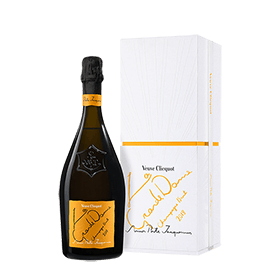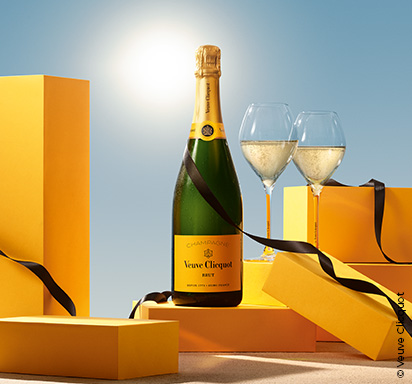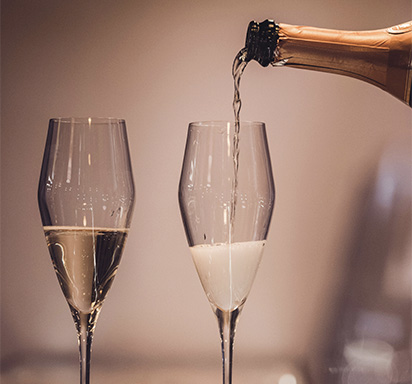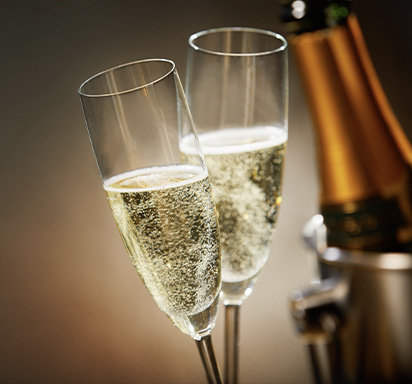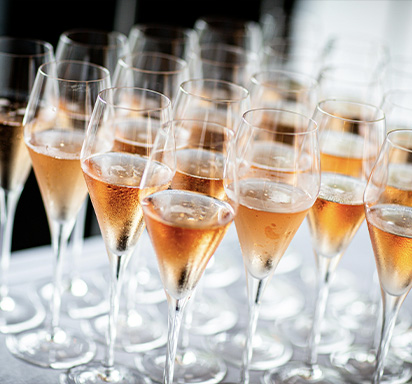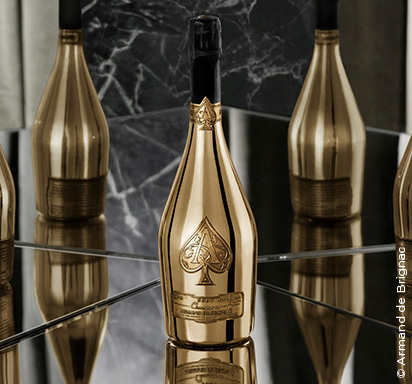Learn how to choose a bottle of Champagne?
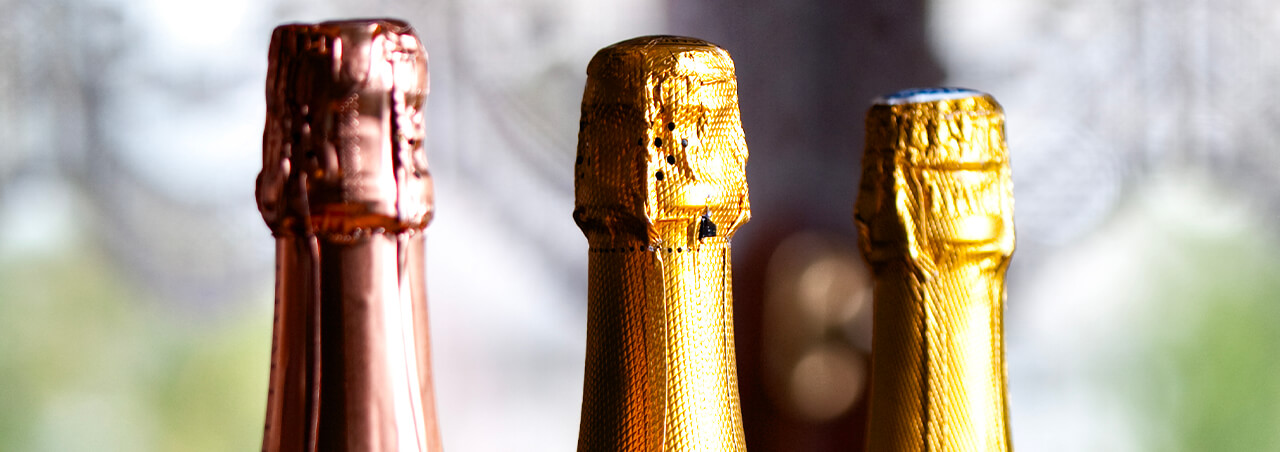
Nothing screams celebration quite like popping open a fine bottle of Champagne at one of your special events. But how do you choose a bottling that matches your event? For a wedding, a meal with friends or a birthday celebration..
Before investing in bottles of champagne, we have put together a list of factors that can help you to make your decision before investing and choosing your perfect bottling.
The very best terroirs shaping the identity of exceptional Champagnes
The AOC currently covers an area of 34,300 hectares, i.e. 280,000 different plots of land, and includes 319 communes, 17 of which are classified as Grand Cru and 44 as Premier Cru. These two regional classifications enable you to know where the grapes are from. The Grand Cru or Premier Cru classifications are a way to determine the quality of the grapes and, therefore, the champagne. These classifications will indeed influence the price of champagne. It is worth noting that many utterly exquisite champagnes stem from other crus, and are equally worthy of your attention.
A harsh climate giving rise to great sparkling wines
As the most northerly vineyard in France, Champagne's main characteristic is that it enjoys two climates. A continental climate with strong winter frosts offset by plentiful sunshine throughout the summer season and an oceanic climate with average annual rainfall. This part of France enjoys an average annual temperature of 10°C and benefits from a limited amount of sunshine, 1680 hours on average per year compared to 2069 hours in the Bordeaux area. Combining all these natural weather conditions shapes the unique identity of the area's wines.
The Champagne region, choosing the best area
The production area of Champagne (delimited in 1927) spreads across five departments in the northern part of France: Marne, Aube, Aisne, Haute-Marne and Seine-et-Marne. The Champagne vineyards extend over four areas: the Montagne de Reims, the Marne Valley, the Cote des Blancs and the Cote des Bar.
The Montagne de Reims
Predominantly planted with Pinot Noir, the Montagne de Reims area is situated between Reims and Epernay. The champagnes from this area are renowned for their rich and flavorsome expression.
The Marne Valley
The vines are rooted in steep hillsides and enjoy their location next to the Marne River. The cooler climate is conducive to the Pinot Meunier varietal, which exudes aromas of mushrooms when aged.
The Cote des Blancs
This area's name refers to the grape variety that is predominantly planted there, Chardonnay. This area is home to lively, mineral Blanc de Blancs champagnes that reveal apricots, honey and toast aromas.
The Cote des Bar
The Cote des Bar is situated south of Champagne and gives rise to rich sparkling wines comprising the Pinot Noir varietal.
What is Champagne? The fruit of the revolutionary Champagne Method
Originally a still wine with no bubbles, this sparkling wine gets its effervescence from the second fermentation. Dom Perignon is at the origin of the Methode Champenoise. The elaboration of what was once referred to as the "devil's wine" gives rise to exceptional vintages that have contributed to the glowing worldwide reputation of many champagne houses. Some world-renowned champagne houses with their iconic cuves are: Veuve Clicquot Champagne, Bollinger Special Cuvee Champagne, and Armand de Brignac's Ace of Spades Brut Gold Champagne.
From still wine to the second fermentation, from the sparkling process to the aging on lees and then from disgorgement to the crucial dosage phase, the art of making fine champagne is the fruit of a rich and age-old savoir faire.
What grape varieties are used in Champagne?
Three grape varieties are mainly used to make up the Champagne blend: Chardonnay, Pinot Noir and Pinot Meunier. The use of these grape varieties greatly determines the expression of each cuvee and the signature style of each house. Some houses boast the use of Chardonnay in the blend, while others use Pinot Noir. Pinot Meunier is considered more as a complementary grape variety in the blends.
Chardonnay, a vital ingredient in high-quality Champagnes
Chardonnay is the most sought-after grape variety in the region. It is precocious and thrives on the chalky soils of the Cote des Blancs. This varietal exhibits an alluring elegance, minerality and a pleasant aromatic palette with floral nuances.
Pinot Noir, divinely scented and fruity
Pinot Noir is the main grape variety planted on the cool, chalky soils of the Montagne de Reims and the Cote des Bar. These grapes produce powerful, rich, structured, round wines that reveal delicate and fruity aromas (plum, dates, coffee and cocoa).
Pinot Meunier, lending its lithe expression
Pinot Meunier is a late-ripening and vigorous grape variety that thrives in clay soils. It is often planted in the Marne Valley. These grapes are predominantly used during the blending stage and give rise to supple and fruity wines.
Rare grape varieties
In addition to these three main grape varieties, which make up 99% of the surface area planted in the appellation, four other varieties are included within the region's specifications: Pinot Blanc, Pinot Gris, Petit Meslier and Arbane.
Various Styles of Champagne
Blanc de Blancs
Sparkling wines made exclusively using the infamous white grape variety, Chardonnay, are called Blanc de Blancs.
Blanc de Noirs
Blanc de Noirs champagnes are white wines that exclusively comprise black-skinned grapes, Pinot Noir and are vinified as a white wine.
Rose Champagne
In order to produce fine Rose champagne, there are two methods; the first method is called rose d’assemblage, also known as blended champagne, and the second is called rose de saignee or macerated champagne.
Rose d’assemblage or the blending method, is when a small amount of red wine, Pinot Noir, is added to a vat of white wine, predominantly Chardonnay. This blend results in a rose wine. The illustrious Ruinart Champagne House use this technique when making their fine Ruinart Rose Champagnes.
The word Saignee can be translated by ‘bleeding’ in French. The saignee method refers to the "bleeding off" or maceration of the must with macerated red-skinned grapes (Pinot Noir or Pinot Meunier).
Organic and Biodynamic champagnes
All Champagne producers share a love for their terroir and take great pride in preserving the area's natural beauty. Thus, many champagne houses are turning towards more nature-minded practices and are embarking on an organic journey. The Telmont Champagne House is producing exquisite organic champagnes, is reducing the house's carbon footprint and is offering an authentic expression of the Champagne terroirs. Organic champagnes sluice forth a fresh expression.
A range of styles enhanced by the dosage
Demi-sec, sec, extra-dry, brut, extra-brut... each of these sweetness levels defines the specific style of a cuvee based on the quantity of grams of sugar added per liter of alcohol. Following disgorgement, the dosage phase consists of adding a "liqueur de dosage", also called "liqueur d'expedition", composed of cane sugar that has dissolved in the wine. Relishing dry or sweet champagne can change the tasting experience. Find out more about the different dosage levels in our article: Types of Champagnes: The many faces of Champagne.
Vintage vs. Non Vintage bubbly
A vintage or non-vintage sparkling wine depends on personal taste and also how much one is willing to spend on champagne.
Vintage Champagne
A fine vintage champagne can express the unique features of a winemaking year. Thus, vintage champagne only comprises grapes from the same year. It is then aged for several years before being released. The result is exquisite and this age-worthy champagne can either be opened or cellared for a few more years. Vintage champagnes will exude bread, butter, and yeast aromas due to the time spent on lees. The price of vintage champagnes is higher, due to the fact that they have spent time in the tranquil and dark cellars of the Champagne House prior to being released.
Non Vintage Sparkling wines
Champagne producers that wish to produce a signature house style, year in and year out, will release non-vintage champagnes. The aromatic palette of champagne evolves over the years in the cellar. Selecting vintage champagne, that has been stored beautifully before arriving on your doorstep will enable you to enjoy a unique tasting experience.
Large format bottlings
Melchisedech, Primat, Methusalem, Jeroboam, Magnum, Bottle or even half-bottles... There is a champagne bottle format for every occasion. Browse a multitude of champagne bottle formats and find the one that will best suit and elevate your event. Pop open a Magnum of champagne and raise a toast with your guests!
What's on the menu? Food and Champagne pairings
Perfect for your aperitifs, a glass of champagne can also be enjoyed throughout your meal. Due to its expression, character, sweetness and blend, each bottle of bubbly will lend itself to a plethora of refined and bold food and wine pairings. A vegetable tempura, scallop carpaccio, truffles, caviar and various of other fine dishes... Pair this wine with starters, meat or fish dishes, or with gourmet desserts and elevate your tasting experience. Find out more in our Champagne and Food pairing Guide!
You may like
Discover the best champagnes under $100 — Moët, Veuve Clicquot, Ruinart, and Laurent-Perrier. Elegant, flavorful, and celebratory, they’re perfect gifts for wine lovers and anyone who cherishes the sparkle of fine champagne.
11/6/2025Brut and Extra Dry Champagne differ in sweetness, with Brut being drier and Extra Dry slightly sweeter. Learn their flavor profiles, food pairings, and which one suits your preference for celebrations and special occasions.
3/17/2025Prosecco and Crémant are both sparkling wines, but their differences lie in production methods, flavor, and origin. Learn about the Charmat and traditional methods, the taste profiles, and the best food pairings for each wine.
1/31/2025Whether you're hosting a small party or a large-scale event, Champagne is the perfect companion for any celebration. But do you know how many bottles to order for your event? Find out now!
1/17/2025Armand de Brignac, the "Ace of Spades," blends centuries-old winemaking by the Cattier family with Jay-Z's flair. Known for its luxurious taste and iconic hand-finished bottles, it offers five prestigious cuvées.
10/8/2024Champagne (or sparkling wine in general) is the wine of choice when it comes to celebration. But what sets it apart from the other fine wines of the world? The answer is simple: the bubbles.
3/7/2023



